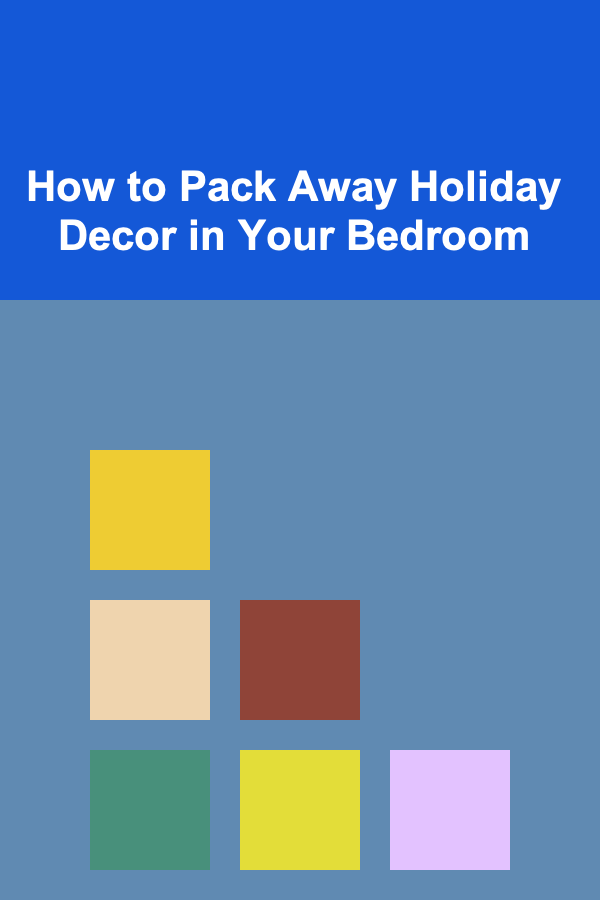
How To Select and Style Ottomans and Poufs
ebook include PDF & Audio bundle (Micro Guide)
$12.99$5.99
Limited Time Offer! Order within the next:

When it comes to interior design, details matter. A well-placed ottoman or pouf can bring a room together, adding both function and style. However, selecting and styling ottomans and poufs isn't always as simple as picking a random piece that looks good. There are several factors to consider, from the size and material to the color and placement. This article will guide you through the process of choosing the perfect ottoman or pouf for your space, and offer tips on how to style them effectively.
Understanding Ottomans and Poufs
Before diving into how to select and style ottomans and poufs, it's important to understand the difference between the two, as well as their purposes in home decor.
Ottomans
An ottoman is typically a low, upholstered piece of furniture that serves a variety of purposes. It can act as a footrest, a coffee table, or even extra seating. Ottomans are often more structured than poufs, and many feature hidden storage compartments, making them functional as well as stylish. Ottomans come in different shapes---square, rectangular, and round---and are usually upholstered in fabrics like leather, velvet, or linen. The height of an ottoman tends to be uniform, usually between 16 to 20 inches, making it ideal for lounging.
Poufs
Poufs are similar to ottomans in that they offer a soft surface for resting your feet, but they are typically more casual and relaxed in design. A pouf is often smaller, more lightweight, and lacks the rigid structure and storage options found in ottomans. Poufs are commonly filled with materials like cotton, wool, or polyester, which gives them a soft, flexible feel. They come in various shapes, such as round, square, and cube, and are often found in bohemian, eclectic, or casual living spaces.
The Role of Ottomans and Poufs in Interior Design
Both ottomans and poufs play an important role in interior design, and their versatility makes them valuable pieces in various types of spaces. Whether you're aiming to create a cozy reading nook, a functional living room, or a decorative accent, these pieces can elevate the overall look of a room. Ottomans and poufs work particularly well in living rooms, bedrooms, and home offices, adding both style and utility.
Now that we've established the basics, let's look at how to select and style ottomans and poufs for your space.
How To Select Ottomans and Poufs
Choosing the right ottoman or pouf requires careful thought and attention to detail. There are several factors to consider, including size, material, color, shape, and functionality.
1. Size Matters
The size of the ottoman or pouf should be in proportion to the size of the room and the furniture around it. A large ottoman in a small room can overwhelm the space, while a small ottoman in a large room can appear insignificant. Here are a few tips for selecting the right size:
- Living Room: If you have a large seating area, opt for an ottoman that complements the scale of the furniture. A larger ottoman can anchor the center of the room or act as a coffee table. In a smaller living room, consider a compact pouf or ottoman that can easily be moved around.
- Bedroom: In the bedroom, ottomans are often placed at the foot of the bed. Choose an ottoman that is proportionate to the width of the bed. Poufs are also great for adding texture and a cozy vibe in front of a vanity or chair.
- Small Spaces: If you have limited space, go for smaller, multifunctional options like a round pouf or an ottoman with hidden storage. These can serve both decorative and practical purposes without crowding the space.
2. Material and Upholstery
The material of an ottoman or pouf not only impacts its appearance but also determines how durable and functional it will be in your space. When selecting a material, consider both style and maintenance.
- Leather and Faux Leather: Leather is a luxurious and timeless material that works well in traditional, modern, and industrial spaces. It is durable and easy to clean, making it perfect for high-traffic areas. Faux leather offers a more affordable option with similar aesthetic appeal.
- Velvet: Velvet is an elegant and sophisticated fabric, ideal for adding a touch of luxury to your space. While velvet ottomans work well in formal settings, they may require more maintenance as they are prone to attracting dust and stains.
- Linen and Cotton: These materials are perfect for a casual, laid-back look. They work well in coastal or bohemian-style spaces. Linen and cotton are breathable and comfortable, but they may not be as durable as leather or velvet.
- Wool and Knit: Wool and knit poufs add texture and warmth to any room, making them ideal for colder climates or cozy spaces. They are often available in a variety of colors and patterns and can serve as a bold statement piece.
- Rattan and Wicker: If you're looking for something more natural, rattan and wicker ottomans are great options. These materials work well in coastal or farmhouse-style homes and often have a casual, organic appeal.
3. Color and Pattern
When choosing the color of your ottoman or pouf, think about the overall color palette of the room. Your ottoman or pouf should either complement or contrast the surrounding decor.
- Neutral Colors: Neutral shades like beige, gray, or taupe are versatile and can blend seamlessly with any decor. If you want your ottoman or pouf to blend into the room, a neutral color is the safest bet.
- Bold Colors: If you're looking to make a statement, choose a bold color like red, navy, or emerald green. A colorful ottoman or pouf can act as a focal point in the room, adding vibrancy and personality.
- Patterns: Ottomans and poufs also come in a variety of patterns. Geometric, floral, and ethnic prints are common, and they can add texture and interest to your space. When using patterned ottomans, make sure they complement the patterns already present in the room, such as the upholstery of your sofa or the rug on the floor.
4. Shape
The shape of your ottoman or pouf will greatly influence the overall design of your room. Each shape creates a different look and feel:
- Square Ottomans: Square ottomans are the most versatile and can be easily placed in front of sofas or chairs. They provide a more formal and symmetrical appearance.
- Round Ottomans and Poufs: Round pieces add a softer, more relaxed vibe to the room. They are particularly effective in small spaces, as they can be placed in corners or along the edges of a seating arrangement.
- Rectangular Ottomans: Rectangular ottomans can act as coffee tables, offering more surface area for decor or drinks. They are perfect for larger rooms with sectional sofas.
- Poufs: Poufs are often smaller and can be used as casual seating or footrests. They come in various shapes, including round, cube, and square, and can be easily moved around to suit your needs.
5. Functionality
One of the most important considerations when choosing an ottoman or pouf is its functionality. What do you need the piece to do? Here are some options to consider:
- Storage Ottomans: If you're short on storage space, an ottoman with hidden storage can be a game-changer. These ottomans often have a lift-up top and can store items like blankets, books, or remote controls.
- Convertible Poufs: Some poufs can be converted into small tables or additional seating. These multifunctional pieces are ideal for spaces where flexibility is key.
- Footrest vs. Seating: While ottomans and poufs are commonly used as footrests, some are designed to serve as extra seating. Choose a piece that suits your specific needs.
How To Style Ottomans and Poufs
Once you've selected the perfect ottoman or pouf, the next step is to style it. The way you position and accessorize your ottoman or pouf can significantly impact the overall aesthetic of the room.
1. Create a Focal Point
An ottoman or pouf can serve as the focal point of a room or simply complement the existing decor. If you want to make your ottoman or pouf a central feature, choose a bold color or unique design. For example, a large, colorful pouf placed in the center of a neutral-toned room can draw attention and create visual interest.
2. Layer with Textiles
Ottomans and poufs can be styled with textiles like throw blankets or decorative pillows to enhance the look. Consider adding a textured throw blanket to a velvet ottoman or a knitted pouf. This adds a cozy, layered feel to the space and creates a more inviting atmosphere.
3. Use as a Coffee Table
If you're using an ottoman as a coffee table, be mindful of its size and functionality. Place a decorative tray on top to hold candles, books, or small plants. This helps ground the piece while maintaining its functionality. A round pouf can also serve as a coffee table in a smaller space, adding a casual vibe to the room.
4. Pair with Other Furniture
To create a cohesive look, pair your ottoman or pouf with complementary furniture. For instance, an ottoman upholstered in a similar fabric or color to your sofa creates harmony in the space. On the other hand, mixing different materials or textures can add depth and interest.
5. Experiment with Placement
Don't be afraid to experiment with different placements. Ottomans can be placed at the foot of a bed, in the middle of a seating area, or near a window. Poufs can be scattered around the room to create a casual, relaxed vibe or placed next to a chair for a cozy reading nook.
Conclusion
Selecting and styling ottomans and poufs is an opportunity to enhance the functionality and aesthetics of your home. By carefully considering size, material, color, shape, and functionality, you can find the perfect piece for your space. Once you've selected the right ottoman or pouf, experiment with different styling techniques to create a cohesive and inviting room. Whether you use them for extra seating, storage, or as decorative accents, ottomans and poufs are versatile pieces that can elevate your home decor.
Reading More From Our Other Websites
- [Simple Life Tip 101] Best Eco‑Friendly Home Hacks for a Zero‑Waste Lifestyle
- [Home Staging 101] How to Stage a Home with Neutral Tones for Broader Appeal
- [Personal Finance Management 101] How to Build a Solid Investment Portfolio for Beginners
- [Needle Felting Tip 101] Pricing Strategies for Handmade Needle-Felted Art: How to Value Your Work
- [Home Party Planning 101] How to Transform Your Backyard into a Summer Party Oasis
- [Organization Tip 101] How to Use Visual Aids for Family Scheduling
- [Personal Care Tips 101] How to Use Soap to Prevent Skin Irritations
- [Personal Finance Management 101] How to Start Real Estate Investing with Little Capital
- [Tie-Dyeing Tip 101] Sustainable Tie‑Dye Techniques: Mastering Earthy Hues with Herbs, Roots, and Fruits
- [Home Budget 101] How to Budget for a Wedding and Still Stay Sane: A Detailed Checklist and Budget Template

How to Deep Clean Your Home Seasonally
Read More
How to Pack Away Holiday Decor in Your Bedroom
Read More
How to Use Labels to Identify Craft Supply Containers
Read More
How to Use Technology to Manage Office Supplies
Read More
Crafting Your Own Snacks and Lunches: A Deep Dive
Read MoreHow to Design a Period Tracker Planner for Specific Health Conditions
Read MoreOther Products

How to Deep Clean Your Home Seasonally
Read More
How to Pack Away Holiday Decor in Your Bedroom
Read More
How to Use Labels to Identify Craft Supply Containers
Read More
How to Use Technology to Manage Office Supplies
Read More